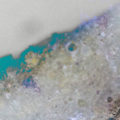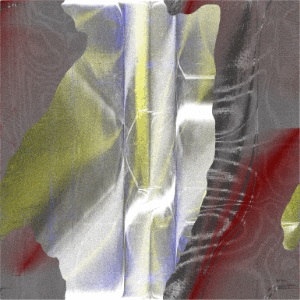Here rests this young producer’s challenge with his debut: for Colorspacious to succeed it must tread a fine line between detached design and bringing ideas to life with musical conviction. Polygrim isn’t quite ripping out his heart but demonstrates a style showing more than promise. His self-imposed limitations are working brilliantly.

Limiting tools to influence his sound
“I read from Brian Eno some time ago that self-imposed limitation, in working with as few tools as possible, can make one think more creatively—out of the box,” writes Polygrim in an email to me. His preparation in creating Colorspacious, this producer’s full-length debut, reflects a self-awareness. In an effort to handle his own creative needs, he’s focused on limiting the tools he can use to influence his sound.
Polygrim is Volodymyr Dzitsiuk who’s based in Kyiv. He’s the other half of video game studio Dustyroom, which he heads in audio and visual art. His studio creates games from a minimalist palette, engrossed in a style of flat shaded art as well as gameplay with simplified mechanics. Dustyroom declares that they remind players to appreciate simplicity in life. Here rests this young producer’s challenge with his debut: for Colorspacious to succeed it must tread a fine line between detached design and bringing ideas to life with musical conviction.
On first listen, there’s a discipline and self-awareness about Colorspacious. The tracks are painstakingly structured, with an array of synths and sound effects progressing and building, alongside an undercurrent of pulsating bass tones. Tracks progress with ascending melodies and end in tender tones. First impressions are an album stunningly crafted, made with deliberation and rationality.
The album opens massively. “Klopfgeist” kicks things off with orchestral strings, as melodic loops are layered with synths and soon after climaxing, fades low tenderly. “Oceanic” is a definite highlight, as Polygrim starts to marry his style with Floex. This track is set in motion with a percussive sequence connected to a melodic sequence. The background of the track is punctured by a tight flute lead, similar to a sound Floex uses so much throughout his work. This penetrates to the front of “Oceanic,” leading us through its many layers—the melodies heard sound enormous as they are layered on top of one another.
Stunningly crafted and meticulously designed
Things quieten down later in Colorspacious, with the gentle “Simple Things Are Warm Blankets” lead by a touching piano. Final track “Smear” has an uplifting melody throughout, as its bright melodic sequence is the beating heart of its sound. What’s fascinating about the last two tracks of the album—intentionally or unintentionally—is that it is as if Polygrim switches to a traditional DJ style, as those whole tracks begin to speed up and slow down, whereas in the beginning of the record, he was content to introduce elements bit by bit.
Colorspacious is an album positioned in between Hidden Orchestra, Floex and John Hopkins. It’s stunningly crafted and meticulously designed. Such design is a thankless task, because at times, it sounds as if Polygrim is designing first and not allowing himself (and us) to get caught up in his musical buoyancy. Colorspacious is tightly crafted, but at times, difficult to get caught up in.
An element of minimalism is detachment. Colorspacious may have had the minimalist of intentions in terms of the tools used to prepare making the album, but at the very least, this is a debut that sounds enormous even if it doesn’t always feel so. Polygrim isn’t quite ripping out his heart in Colorspacious but demonstrates a style showing more than promise. His self-imposed limitations are working brilliantly.
Colorspacious is available on Bandcamp.


















![Pole :: Tempus Remixes (Mute) — [concise]](https://igloomag.com/wp/wp-content/uploads/2025/04/pole-tempus-remixes_feat-75x75.jpg)






![Hasbeen :: Bunker Symphonies II (Clean Error) — [concise]](https://igloomag.com/wp/wp-content/uploads/2025/04/hasbeen-bunker-symphonies-ii_feat-75x75.jpg)
